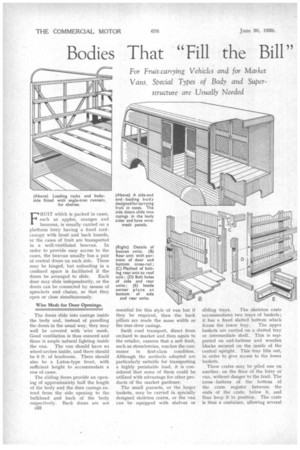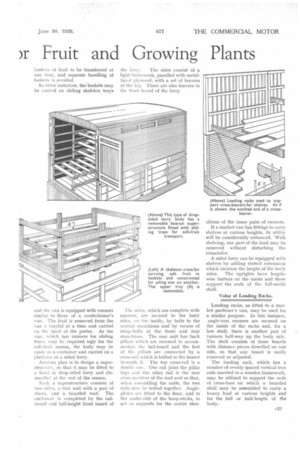Bodies That "Fill the Bill" )r Fruit and Growing Plants
Page 64

Page 65

If you've noticed an error in this article please click here to report it so we can fix it.
For Fruit.canying Vehicles and for Market Vans, Special Types of Body and Super-. structure are Usually Needed F,RUIT which is packed in cases, such as apples, oranges and bananas, is usually carried on a platform lorry having a fixed roofcanopy with front and back boards, or the cases of fruit are transported in a well-ventilated boxvan. In order to provide easy access to the cases, the boxvan usually has a pair of central doors on each side. These may be hinged, but unloading in a confined space is facilitated if the
doors be arranged to slide. Each door may slide independently, or the doors can be connected by means of sprockets and chains, so that they open or close simultaneously.
Wire Mesh for Door Openings.
The doors slide into casings inside the body and, instead of panelling the doors in the usual way, they may well be covered with "wire mesh. Good ventilation is thus ensured and there is ample natural lighting inside the van. The van should have no wheel-arches inside, and there should be 6 ft. of headroom. There should also be a Luton-type front, with sufficient height to accommodate a row of cases.
The sliding doors provide an opening of approximately half the length of the body and the door casings extend from the side opening to the bulkhead and back of the body respectively. Back doors are not c22 essential for this style of van but if they be required, then -the back pillars are made the same width as the rear-door casings.
Swift road transport, direct from orchard to market and then again to the retailer, ensures that a soft fruit, such as strawberries, reaches the consumer in first-class condition. Although the methods adopted are particularly suitable for transporting a highly perishable load, it is considered that some of them could be utilized with advantage for other products of the market gardener.
The small punnets, or the larger baskets, may be carried in specially designed skeleton crates, or the van can be equipped with shelves or sliding trays. The skeleton crate accommodates two trays of baskets; it has a fixed slatted bottom which forms the lower tray. The upper baskets are carried on a slatted tray or intermediate shelf. This is supported on end-battens and wooden blocks secured on the inside of the central upright. This tray lifts out, in order to give access to the lower baskets.
These crates may be piled one on another, on the floor of the lorry or van, without danger to the fruit. The cross battens of the bottom of the crate register between the ends of the crate, below it, and thus keep it in position. The crate is thus a container, allowing several baskets of fruit to be transferred at one time, and separate handling of baskets is avoided.
In other instances, the baskets may be carried on sliding skeleton trays and the van is equipped with runners similar to those of a confectioner's van. The fruit is removed from the van a trayful at a time and carried on the head of the porter. As the van, which has runners for sliding trays, may by required only for the soft-fruit season, the body may be rnade as a container and carried on a platform or a sided lorry.
Another plan is to design a superstructure, so that it may be fitted to n fixed or drop-sided lorry and dismantled at the end of the season.
Such a superstructure consists of two sides, a rear unit with a pair of doors, and a boarded roof. The enclosure is completed by the tailboard and full-height front board of
the lorry. The sides consist of a light framework, panelled with metalfaced plywood, with a set of louvres at the top. There are also louvres in the front board of the lorry.
The sides, which are complete with runners, are secured to the lorry sides, on the inside, by bolts to the central stanchions and by means of strap-bolts at the front and rear stanchions. The rear unit has back pillars which are recessed to acOominedate the tail-board and the feet of the pillars are connected by a cross-rail which is bolted to the bearer beneath it. The top cross-rail is a double one. One rail joins the pillar taps and the other rail is the rear cross-member of the roof unit so that, when assembling the units, the two rails may be bolted together. Angieplates are fitted to the floor, and to the underside of the hoop-sticks, to act as supports-for the centre stan
chions of the inner pairs of runners.
If a market van has fittings to carry shelves at various heights, its utility will be considerably enhanced. With shelving, one part of the load may be removed without disturbing the remainder.
A sided lorry can be equipped with shelves by adding slatted extensions which increase the height of the body sides. The uprights have lengthwise battens on the inside and these support the ends of the full-width shelf.
Value of Loading Racks.
Loading racks, as fitted to a market gardener's van, may be used for a similar purpose. In this instance, angle-iron runners are secured on the inside of the racks and, for a low shelf, there is another pair of runners half-way up the body side. The shelf consists of -loose boards with distance pieces dowelled on one side, so that any board is easily removed or adjusted.
The loading rack, which has a number of evenly spaced vertical iron rods inserted in a wooden framework, may be utilized to support the ends of cross-bars on which a boarded shelf may be assembled to carry a heavy load at various heights and for the full or half-length of the body.




































































































































